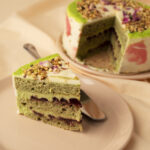Matcha, or powdered green tea, has gained popularity for its unique flavor and vibrant green color. If you’re a fan of matcha and want to create a delicious and visually appealing cake, here are some tips to help you make the best matcha (green tea) cake:
- Choose High-Quality Matcha Powder: Start with high-quality matcha powder for the best flavor and color. Look for ceremonial-grade matcha, which is known for its vibrant green color and smooth taste. Avoid culinary-grade matcha, as it may have a slightly bitter taste and dull color.
- Sift the Matcha Powder: To ensure a smooth and lump-free batter, sift the matcha powder before adding it to the dry ingredients. This step helps break up any clumps and ensures even distribution of the matcha throughout the cake.
- Balance the Matcha Flavor: Matcha has a strong and distinct flavor, so it’s important to balance it correctly. Adjust the amount of matcha powder according to your taste preference. If you prefer a more pronounced matcha flavor, you can increase the amount slightly. Be cautious not to add too much, as it can result in a bitter taste.
- Use Unsalted Butter: Opt for unsalted butter to have better control over the overall saltiness of the cake. This allows you to adjust the salt content according to your taste.
- Cream Butter and Sugar: Creaming the butter and sugar together until light and fluffy is a crucial step in creating a tender and moist cake. Use a stand mixer or an electric hand mixer to achieve the right consistency. Cream the butter and sugar for a few minutes until the mixture is pale in color.
- Incorporate Dry and Wet Ingredients: Alternate adding the dry ingredients (flour, matcha powder, baking powder, and salt) and the wet ingredients (milk, vanilla extract) to the creamed butter and sugar mixture. Start and end with the dry ingredients, incorporating them in batches. Mix just until the ingredients are combined to avoid overmixing.
- Use Buttermilk for Moisture: To ensure a moist and tender matcha cake, consider using buttermilk in the batter. The acidity of the buttermilk helps tenderize the cake and adds moisture. If you don’t have buttermilk, you can make a substitute by adding a tablespoon of lemon juice or white vinegar to regular milk and letting it sit for a few minutes.
- Avoid Overmixing: Overmixing the batter can lead to a dense and tough cake. Mix the ingredients just until they are combined, and avoid excessive stirring. This helps ensure a lighter and fluffier texture.
- Bake at the Right Temperature: Follow the recommended baking temperature in the recipe. Generally, matcha cakes are baked at around 350°F (175°C). Check for doneness by inserting a toothpick or cake tester into the center—it should come out clean or with a few moist crumbs attached. Avoid overbaking to retain the softness and moisture of the cake.
- Cool and Frost: Allow the matcha cake to cool in the pan for about 10 minutes before transferring it to a wire rack to cool completely. Once the cake is fully cooled, you can frost it with a complimentary frosting such as cream cheese frosting, white chocolate ganache, or matcha buttercream. These frostings enhance the matcha flavor and add a delicious finishing touch.
- Garnish with Matcha Powder or White Chocolate Shavings: For a visually appealing presentation, dust the top of the frosted cake with a sprinkle of matcha powder or add some delicate white chocolate shavings. These garnishes add a touch of elegance and hint at the flavor inside.
- Slice and Enjoy: Once the matcha cake is fully decorated, slice it into generous portions and savor the unique and refreshing taste of matcha. Enjoy it as a delightful dessert or pair it with a cup of green tea for a complete matcha experience.
By following these tips, you’ll be able to create a beautiful and delicious matcha cake that showcases the distinct flavor and vibrant green color of matcha. Embrace the art of baking with matcha and enjoy the unique taste and visual appeal of your homemade creation.








